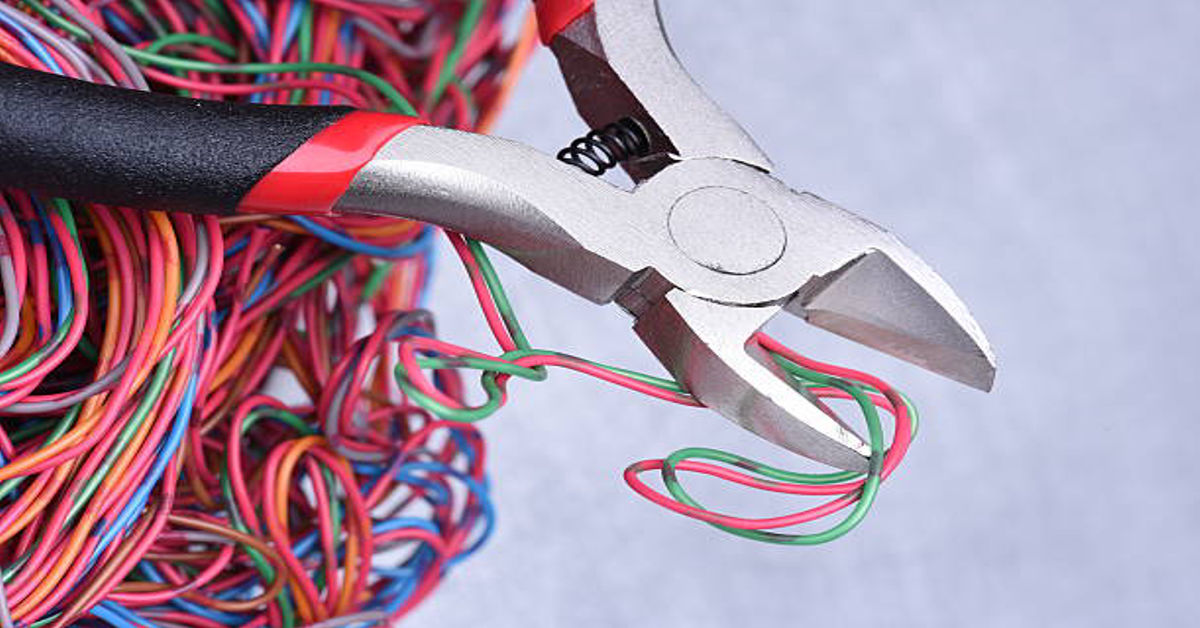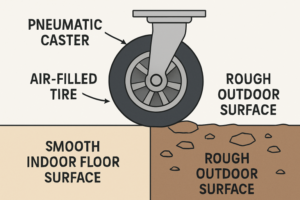A wire cutter is one of the most essential tools in every electrician’s, mechanic’s, and DIY enthusiast’s toolkit. Whether you are stripping electrical wires, cutting steel rods, trimming cable ties, or working on delicate electronics, a wire cutter plays a vital role in ensuring precision, safety, and efficiency. Over time, the wire cutter has evolved from a simple manual tool to a sophisticated instrument available in multiple designs and materials suited for different applications.
In this detailed guide, we will explore every aspect of wire cutters—including their construction, functionality, material composition, safety considerations, maintenance tips, and the factors to consider before purchasing one. We will also highlight the different categories of wire cutters and their unique advantages.
1. Introduction to Wire Cutters
A wire cutter is a hand tool designed primarily to cut through various types of wire and cables. It typically consists of two handles, a pivot joint, and sharp cutting jaws. The tool works on the principle of leverage—when you squeeze the handles together, the cutting blades close on the wire, slicing through it efficiently.
Wire cutters are used in a wide range of applications, including electrical installations, jewelry making, automotive repairs, telecommunications, fencing, and crafting. Depending on the intended purpose, wire cutters come in several types and sizes, ranging from small precision tools to large heavy-duty cutters capable of cutting through thick metal cables.
2. Parts and Construction of a Wire Cutter
To understand how a wire cutter functions, it’s essential to look at its basic components. The design may vary slightly among models, but the fundamental structure remains the same.
| Part Name | Description | Function |
|---|---|---|
| Handles | Usually made of metal and covered with an insulated grip | Provide leverage and comfort while cutting |
| Pivot Joint | The point where both arms meet | Acts as a fulcrum to multiply force |
| Cutting Blades/Jaws | Sharp edges made of hardened steel | Slice or shear the wire cleanly |
| Spring Mechanism (optional) | A small spring between handles | Helps return the tool to open position automatically |
| Insulation Coating | Plastic or rubber coating | Protects the user from electric shocks when cutting live wires |
Each component works together to ensure durability, comfort, and precision. High-quality cutters are often made with chrome vanadium steel or high-carbon steel, ensuring they remain sharp and rust-free even after extensive use.
3. Working Principle of a Wire Cutter
Wire cutters work on the mechanical advantage of leverage. When you press the handles, the force you apply is transferred through the pivot point, magnifying the cutting power at the jaws. This allows you to cut through tough materials with less physical effort.
For example, in a long-handled wire cutter, the handles are designed to provide a higher leverage ratio. This means that even a moderate amount of pressure at the handles can generate a significant cutting force at the jaws, allowing the user to cut thicker or harder wires easily.
4. Types of Wire Cutters
Wire cutters come in various designs tailored to specific tasks. Below are the major categories:
| Type of Wire Cutter | Primary Use | Distinct Feature |
|---|---|---|
| Diagonal Cutting Pliers | General-purpose wire cutting | Jaws are angled to provide flush cuts |
| End Cutting Pliers | Cutting close to surfaces | Flat cutting edge at the tip |
| Needle-Nose Cutters | Working in tight spaces | Long, slender nose with cutting edge |
| Cable Cutters | Cutting thick electrical or steel cables | Curved blades for clean cuts |
| Bolt Cutters | Cutting through bolts, rods, chains | Long handles for high leverage |
| Wire Rope Cutters | Cutting wire ropes and strands | Precision-cutting jaws to prevent fraying |
| Flush Cutters | Electronics and jewelry making | Provide clean, flat cuts on soft wire |
| Stripper-Cutter Combination Tools | Electricians’ multitool | Cuts and strips insulation simultaneously |
5. Materials Used in Wire Cutters
The material composition of a wire cutter determines its durability, strength, and corrosion resistance. The most common materials include:
- High-Carbon Steel: Offers excellent hardness and edge retention. Ideal for cutting hard metal wires.
- Chrome Vanadium Steel: Provides toughness and resistance to wear and corrosion.
- Stainless Steel: Used in lightweight or precision wire cutters for rust resistance.
- Alloy Steel with Nickel Coating: Enhances strength and adds a layer of protection against moisture.
The cutting edges are often induction-hardened to ensure they retain sharpness for a long time. Handles are generally covered with non-slip PVC or rubber insulation for comfort and safety.
6. Applications of Wire Cutters
Wire cutters are indispensable across industries due to their versatility. Here are the most common applications:
- Electrical Work – Cutting electrical wires, trimming leads, and removing insulation.
- Electronics and Circuit Boards – Precise cutting of delicate wires and components.
- Automotive Repairs – Cutting cables, brake wires, and fasteners.
- Construction and Fencing – Trimming steel mesh, rebar ties, and fence wire.
- Jewelry Making – Shaping and cutting soft metal wires.
- Craft and Hobby Work – Useful for art projects, model building, and DIY creations.
- Telecommunications – Cutting fiber optic and copper cables neatly.
7. Differences Between Wire Cutters and Pliers
Although wire cutters may look similar to pliers, their functions differ significantly. The following table highlights their distinctions:
| Feature | Wire Cutters | Pliers |
|---|---|---|
| Primary Function | Cutting wires | Gripping, bending, or twisting |
| Jaw Shape | Sharp cutting edges | Flat or serrated surfaces |
| Material Hardness | Typically harder for cutting | Slightly softer |
| Use in Electrical Work | Cutting conductors | Holding connectors or wires |
| Edge Type | Beveled or flush cutting edges | Non-cutting jaws |
In many toolkits, both pliers and wire cutters are necessary for different stages of a task.
8. Safety Precautions While Using Wire Cutters
Safety is a major consideration when using any cutting tool. A wire cutter, although small, can cause injuries or damage if mishandled. Here are key precautions:
- Wear Protective Gear: Always wear safety goggles to protect your eyes from flying wire pieces.
- Check for Live Wires: Never cut live electrical wires unless the cutter is insulated and rated for electrical use.
- Inspect Before Use: Ensure the blades are not chipped or misaligned.
- Use the Right Cutter: Choose the correct type and size for the material you’re cutting.
- Apply Proper Force: Avoid excessive pressure that can damage the tool or cause slippage.
- Store Safely: Keep the tool dry and locked away when not in use.
- Cut Perpendicular: Position the wire at a right angle to the blades for a clean and efficient cut.
9. Maintenance and Care Tips
A well-maintained wire cutter not only lasts longer but also ensures clean and accurate cuts. Here are some maintenance guidelines:
- Cleaning: Wipe the cutter after each use with a dry cloth to remove dust, oil, or residue.
- Lubrication: Apply a drop of machine oil at the pivot joint to prevent rust and ensure smooth operation.
- Sharpening: If the edges become dull, use a fine file or sharpening stone designed for hardened steel.
- Storage: Keep in a dry, moisture-free toolbox. Use blade covers if available.
- Rust Prevention: For long-term storage, apply a thin coat of anti-corrosive oil.
10. Choosing the Right Wire Cutter
Selecting the right wire cutter depends on your application, material, and comfort. Here are the major factors to consider before purchasing:
| Factor | Recommendation |
|---|---|
| Material Type | Use high-carbon or chrome vanadium steel for durability |
| Wire Thickness | Choose heavy-duty cutters for thicker wires |
| Handle Comfort | Prefer insulated, ergonomic grips |
| Cutting Edge Type | Flush cutters for clean cuts; beveled for heavy-duty work |
| Size and Length | Short handles for precision; long handles for power |
| Insulation Rating | For electricians, select cutters rated for live electrical work |
| Brand and Warranty | Trusted manufacturers offer better build quality and safety certification |
11. Wire Cutter vs. Cable Cutter
Although both tools cut wires, cable cutters are generally designed for thicker and more complex materials such as steel cables or multi-strand conductors. Wire cutters, on the other hand, are ideal for smaller, single-strand wires.
| Feature | Wire Cutter | Cable Cutter |
|---|---|---|
| Blade Type | Straight or diagonal | Curved to cradle the cable |
| Cutting Capacity | Small to medium wires | Thick cables and wire ropes |
| Precision | High | Moderate |
| Leverage | Medium | High |
| Common Use | Electronics, electrical work | Construction, heavy industry |
12. Innovations and Modern Developments
Modern wire cutters have undergone several design improvements for better performance and safety. Some innovations include:
- Self-Adjusting Wire Stripper-Cutters: These automatically adjust to wire size, combining cutting and stripping in one motion.
- Insulated Handles with Voltage Ratings: Ensures safe use up to 1000 volts.
- Compound Leverage Mechanisms: Provides increased cutting power with less effort.
- Replaceable Cutting Blades: Extends tool life and reduces cost of replacement.
- Spring-Loaded Mechanisms: Enhance comfort by reducing hand fatigue during repetitive tasks.
13. Common Problems and Solutions
| Problem | Cause | Solution |
|---|---|---|
| Blades become dull quickly | Cutting hard materials frequently | Use cutters rated for those materials |
| Stiff pivot movement | Lack of lubrication | Apply light oil regularly |
| Uneven cuts | Misaligned jaws | Adjust or replace the cutter |
| Rust formation | Storage in damp environment | Clean and oil after use |
| Slipping from hand | Worn-out handle grip | Replace or use grip covers |
14. Environmental and Industrial Importance
Wire cutters play a crucial role in both small-scale and large-scale industries. In the electrical and construction sectors, they ensure quick and precise wiring. In recycling plants, they are used to separate copper wires from insulation. Manufacturing industries rely on them to trim excess wires in automated production lines.
Moreover, using a properly sized cutter reduces material wastage and improves safety standards, thereby promoting sustainable practices.
15. Comparison Table of Popular Wire Cutter Types
| Cutter Type | Ideal For | Jaw Design | Handle Type | Special Feature |
|---|---|---|---|---|
| Diagonal Cutter | General use | Angled | Short handle | Clean angled cuts |
| End Cutter | Nail or wire removal | Flat | Medium | Flush cutting |
| Needle-Nose Cutter | Tight spaces | Long and pointed | Small handle | Precision tip |
| Cable Cutter | Thick cables | Curved | Long handle | High leverage |
| Flush Cutter | Electronics | Straight | Short handle | Smooth edge |
| Bolt Cutter | Chains, rods | Dual blade | Long handle | Heavy-duty strength |
16. Advantages of Using Wire Cutters
- Precision Cutting: Clean cuts prevent fraying and short-circuits.
- Versatility: Works on various materials like copper, aluminum, steel, and brass.
- Efficiency: Quick, effortless cutting saves time.
- Durability: High-grade materials ensure long lifespan.
- Ergonomic Design: Modern handles reduce hand strain.
- Safety: Insulated handles minimize risk of electric shock.
17. Disadvantages and Limitations
While wire cutters are extremely useful, they do have certain limitations:
- Limited Cutting Capacity: Not suitable for very thick or hardened materials.
- Bluntness Over Time: Regular sharpening required.
- Handle Wear: Insulation can degrade with time.
- Improper Use Risk: Using them for prying or twisting can damage the blades.
18. Cost and Value Consideration
Wire cutter prices vary depending on build quality, brand, and size. Generally, prices range as follows:
| Category | Price Range (Approx.) | Suitable For |
|---|---|---|
| Basic Handheld Cutters | $5 – $20 | Home and DIY use |
| Professional Electrical Cutters | $20 – $60 | Electricians and technicians |
| Heavy-Duty Cable/Bolt Cutters | $60 – $150+ | Industrial and mechanical work |
A high-quality cutter may cost more initially but proves cost-effective due to durability and reduced maintenance needs.
19. Proper Techniques for Cutting Wires
To achieve clean cuts and prevent damage:
- Position the wire correctly within the jaws.
- Apply even pressure—avoid jerky movements.
- Do not twist the wire while cutting.
- Avoid overloading the tool by cutting beyond its rated capacity.
- Check alignment before applying full force.
20. Conclusion
A wire cutter may appear as a small, simple tool, but its role in modern technology, construction, and electrical work is irreplaceable. From cutting delicate electronic leads to slicing through thick industrial cables, wire cutters come in many forms to serve diverse purposes. Understanding their structure, functionality, and safe usage ensures that you not only achieve precision but also maintain the longevity of your tool.
Whether you are an electrician, hobbyist, or industrial worker, investing in a high-quality wire cutter with the right specifications is essential. With proper care, a reliable wire cutter can serve efficiently for years, making it one of the most valuable tools in any toolkit.
FAQs
1. What is the difference between a wire cutter and a wire stripper?
A wire cutter is designed to cut the metal conductor itself, while a wire stripper removes the outer insulation without damaging the wire inside.
2. Can wire cutters cut steel wire?
Yes, but only if the wire cutter is made of hardened steel and rated for cutting such materials. Using a basic cutter may dull or damage the blades.
3. How often should I sharpen my wire cutter?
It depends on usage. For regular users, sharpening every few months is advisable. For occasional use, once or twice a year may suffice.
4. Are insulated wire cutters safe for live electrical work?
Yes, insulated cutters with a voltage rating (typically up to 1000V) are specifically designed for cutting live wires safely.
5. How can I prevent rust on my wire cutter?
Keep it clean, dry, and lightly oiled. Avoid storing it in humid environments, and always wipe it after use.









